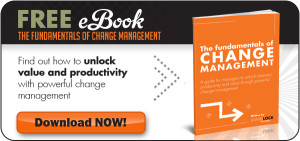Wednesday, September 17, 2014


In my last article I began to examine the common approach to change management within an organisational change program, and why two-thirds of such change programs fail. With four drivers of cultural change identified, it has also been seen by numerous studies that the reasons for failure falls squarely on the shoulders of change management and a lack of understanding of human behavioural patterns.
Predictable irrationality as a starting point for cultural change
Once the predictability of human irrationality has been accepted, it becomes easier for a change management approach to be adapted from the four cultural change drivers. By asking themselves a number of key questions, leaders of organisational change will be able to onboard employees earlier and create the environment for cultural change that will bring a change program its success.
Having discussed the areas of creation of a compelling organisational change story and becoming an example of new behaviours, here I look at the remaining two drivers of cultural change: change reinforcement and employee capability.
How to reinforce cultural change
Change management practice iterates the importance of ?before, during, and after? care. This generally is positioned with training and coaching, and rewarding with regards to set targets, uptake of systems and processes, so on and so forth. However, change management leaders find that this is an area where human irrationality reaches its heights.
Money doesn?t always talk in the process of organisational change
Although one of the main reasons for organisational change will be financial ? the pursuit of lower costs and higher profits ? paradoxically this is unlikely to be a major motivator for employees. While this may seem strange (who isn?t concerned about pay and remuneration?), it actually makes sense.
Organisational change is often measured with a number of metrics which will be new and therefore difficult to understand for many. Also, employees know that perception is commonly different to reality. In the words of Cuba Gooding when speaking to Tom Cruise?s Jerry Maguire: ?Show me the money!? More commonly on the shop floor, you?ll hear the words, ?I?ll believe it when I see it.?
Incentives and bonuses will be important, but unexpected gifts are also received well. Think of the positive impact a simple gift voucher will make when given to a staff member for performing well with a client. A friend of mine worked for a financial institution in London that gave all its employees a bottle of whiskey and aa fresh turkey for Christmas one year. Morale increased disproportionately. When thinking about incentives and rewards, ask these questions:
- Do employees understand why the reward has been given?
- Do rewards or incentives mean something to the person rewarded (for example, would a 19 year old customer services rep be likely to enjoy a night at the opera)?
Practice fairness throughout organisational change
While it?s necessary to appeal to the self-interests of individuals, they will expect any organisational change to be executed with fairness to all, including customers. Consider a restaurant that makes sweeping changes to its menu. Customers have been coming for years because they are happy with the food the way it is. The chef knows the old menu inside out, as do the waiting staff, but the owner has decided a new look is called for. Waiting staff can?t wait to bad mouth the decision to regulars, who fail to return and new customers are put off by the bad atmosphere. Revenues and profits collapse faster than a cold soufflé.
On a more global scale, JC Penney?s attempt at reengineering itself as a higher end retailer backfired catastrophically: employees didn?t understand the change, and customers didn?t want the change. To avoid this type of failure, ask yourself these questions:
- Does the change ask too much of one section of the company?
- Do the metrics of success make sense, and are they easily measured and understood?
- Does the organisational change impact customers, and what extra strain will be placed upon frontline staff?
- Am I communicating the fair state of play well enough?
Pay attention to the value of building capability for cultural change
New systems, processes, and procedures are likely to require an upgrade of skills and abilities. However, though this need is unequivocal, change management leaders are prone to ignore the factors which drive behaviour. In attempting to enforce cultural change, you should remember that behaviour is driven by the values and beliefs of your people.
This is exactly how Lou Gerstner managed to turn around IBM. He didn?t attempt to rip apart inherent values, beliefs, and skills. Instead he studied the company?s history, and turned all of its existing corporate identity into organisational change assets. From a culture of hardware, he created the world?s biggest consulting service.
Gerstner put in place a series of coaching events and a training regime that involved IBM people in design and structure, with targeted training to personalities and intellects. Ask these questions when designing a change program to increase skills and capabilities:
- Am I considering my employees as individuals?
- Have I paid enough attention to the impact of cultural change on existing values and beliefs?
- Have I considered the integration of internal and external requirements for all stakeholders?
In conclusion
Cultural change impacts all stakeholders of organisational change. How a change program is led determines its success.
An enforcing attitude is the quickest way to encounter resistance to change management. Throughout the process of change, a leader must be an exemplar of the new culture and bring on board all impacted stakeholders.
Questioning change process and methods, and placing yourself in the shoes of those affected by the organisational change will bring the important issues clearly into focus. When this happens, your change program?s chances of success will increase exponentially.

